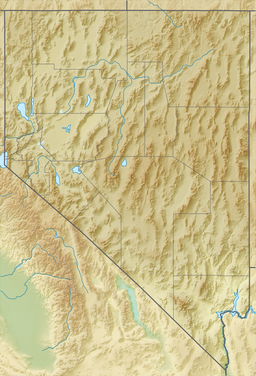| Walker Lake | |
|---|---|
| Agai Pah[1] (Northern Paiute) | |
 Walker Lake with Hawthorne Army Depot in the foreground | |
| Location | Mineral County, Nevada, United States |
| Coordinates | 38°41′32″N 118°44′10″W / 38.69222°N 118.73611°W |
| Primary inflows | Walker River (Does not reach Walker Lake in most years) |
| Primary outflows | evaporation |
| Catchment area | Walker River Basin |
| Basin countries | United States |
| Max. length | 11 mi (18 km) |
| Max. width | 5 mi (8.0 km) |
| Surface area | 130 km2 (50 sq mi) |
| Max. depth | 68 ft (21 m) |
| Surface elevation | 3,960 ft (1,207 m)[2] |
Walker Lake is a natural lake in the Great Basin in western Nevada in the United States. It is 11 mi (17 km) long and 5 mi (8 km) wide, in northwestern Mineral County along the east side of the Wassuk Range, about 75 mi (120 km) southeast of Reno. The lake is fed from the north by the Walker River and has no natural outlet except absorption and evaporation. The community of Walker Lake is found along the southwest shore.
Its name in the Northern Paiute language is Agai Pah, which means "trout lake." Walker Lake and the surrounding area play a significant social and cultural role for many Northern Paiutes whose ancestors inhabited the area around the lake and depended on the lake's fish and bird populations for food.[3]
Throughout the 20th century, Walker Lake supported over 50% of the economy of Mineral County through tourism and recreation.[4] From fishing derbies to boat races, water skiing to an annual Loon Festival, the lake was a key part of Mineral County and Walker River Paiute communities.
More than a century of upstream irrigation diversions of the Walker River have left Walker Lake in a state of ecological collapse.[5] As inflows have decreased and more water evaporated, the concentration of salts in the lake has increased dramatically. Walker Lake no longer supports fish life. Since the 1850s, Walker Lake has declined by 90% in terms of volume and more than 50% in terms of surface area.
Walker Lake is the focal point of significant restoration, conservation efforts, and litigation. Through the Walker Basin Restoration Program, former irrigation rights are being acquired and protected in instream for environmental benefit. The program delivered water to the lake in 2019 for the first time and aims to restore Walker lake to a state that supports fish and bird life.[6] Mineral County and the Walker River Paiute Tribe have both brought litigation to protect Walker Lake and flows to the lower Walker River. These efforts have established the public trust doctrine in Nevada, though the lawsuit has yet to improve flows to the lake.[7]


- ^ Ginny Bengston (2002). Northern Paiute and Western Shoshone Land Use in Northern Nevada: A Class I Ethnographic/Ethnohistoric Overview (PDF). SWCA Environmental Consultants. p. 91. Retrieved December 30, 2022.
- ^ U.S. Geological Survey Geographic Names Information System: Walker Lake (Nevada)
- ^ Ginny Bengston (2002). Northern Paiute and Western Shoshone Land Use in Northern Nevada: A Class I Ethnographic/Ethnohistoric Overview. SWCA Environmental Consultants. pp. 91, 111. Retrieved 2022-12-31.https://www.blm.gov/sites/default/files/documents/files/Library_Nevada_CulturalResourceSeries12.pdf
- ^ Bahouth, Brian (September 29, 2020). "Walker Lake - the legal saga continues with the endgame in question". Sierra Nevada Ally. Retrieved June 2, 2022.
- ^ Chereb, Sandra (April 26, 2009), "Loon festival canceled - the lake is drying up", San Francisco Chronicle, pp. A–2
- ^ Walker Basin Conservancy 2019 Press Release - https://static1.squarespace.com/static/550a1fc8e4b0e1de27f15703/t/5d377af7c6dce00001b679fd/1563917048648/Walker+Lake+Receives+Restoration+Water+For+First+Time.pdf
- ^ "9th Circuit to District Court: Consider 'public trust' remedies in Walker Lake case". The Nevada Independent. Retrieved June 1, 2022.
